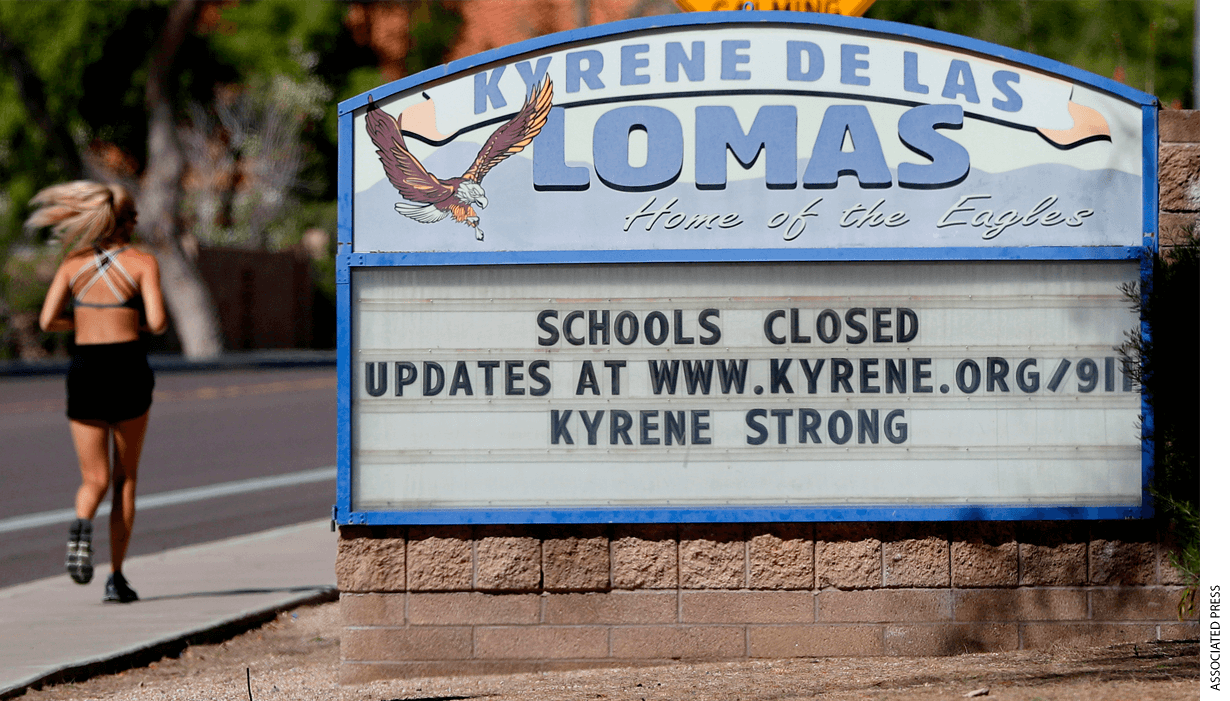The 2020 Education Next survey reveals a paradox related to what American parents think about the quality of the instruction their children received after schools closed their doors in response to the Covid-19 pandemic. The parents of a substantial majority of school-aged children—71%—think their kids learned less than they would have in school. At the same time, parents of 72% of children say they are satisfied with the instruction and activities provided by schools during the closure (see Figure 1).
What experiences account for these seemingly contradictory opinions? And how did those experiences vary across social groups and the nation’s district, charter, and private school sectors? Since schools closed, commentators have used a variety of methods to understand the likely implications of this episode for student learning and what it bodes for the future, from analyzing school districts’ remote-learning plans to tracking reports of homeschooling on social media. Yet we lack a thorough and systematic picture of what American families experienced during the pandemic.
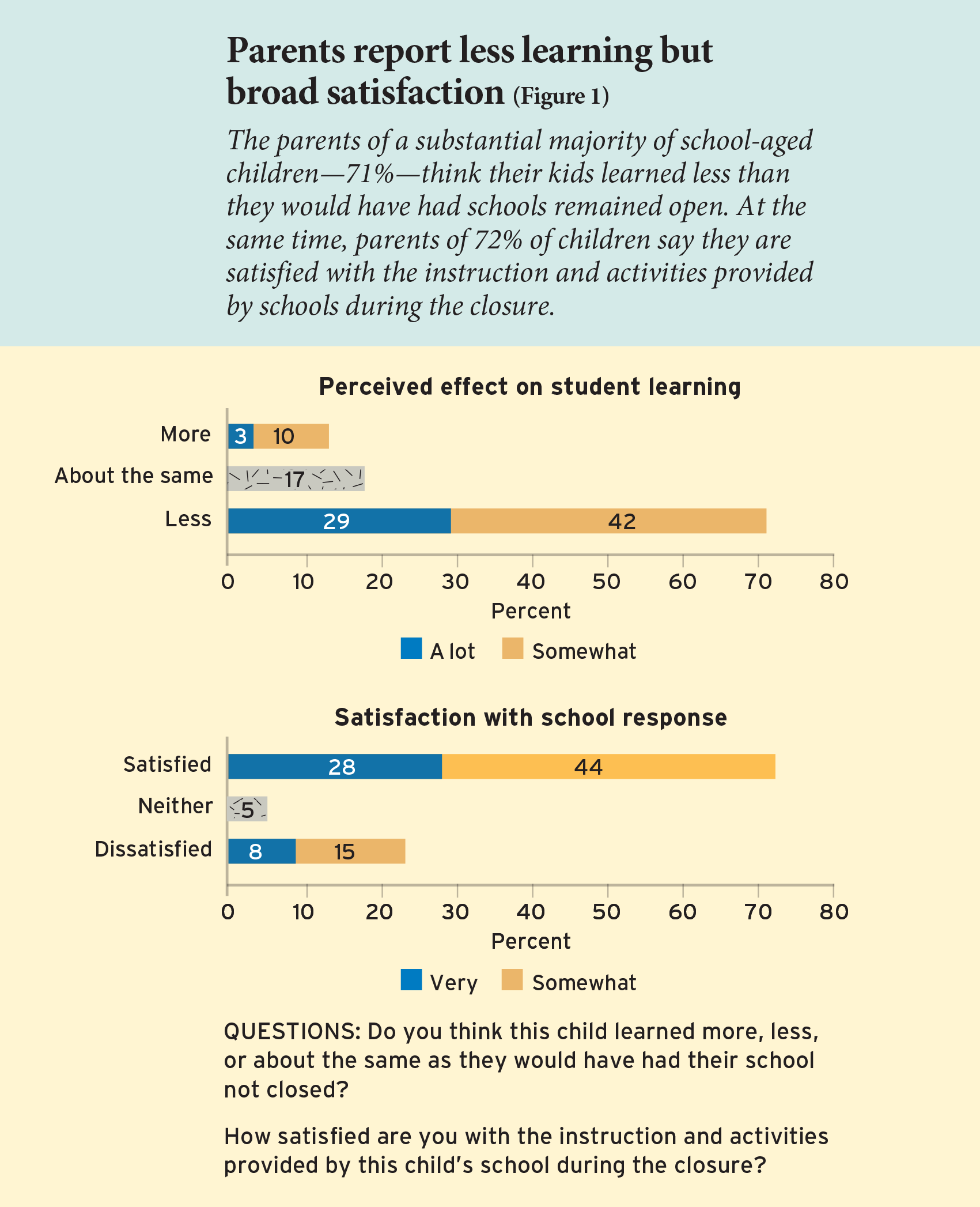
New data from our 14th annual public-opinion survey help to close this gap. We administered the survey to a nationally representative sample of 1,249 parents with children in kindergarten through 12th grade whose schools closed during the pandemic, including oversamples of parents who identify as Hispanic and parents who identify as Black (see sidebar for details on the survey methodology). These parents answered questions about each of their children whose school closed, including 2,147 children in total. We also gathered data from a nationally representative sample of 490 K–12 teachers whose schools closed because of the pandemic, enabling us to compare what parents reported receiving to what teachers said they delivered.
A New Learning Landscape
Despite early fears that schools would focus remote instruction on reviewing what students had already learned, parents’ responses suggest that the schools attended by 74% of students continued to introduce new content during the closure (see Figure 2). Most of the rest—schools attended by 24% of the children—are said to have provided instruction or activities that reviewed what students had learned prior to the closure. Parents of just 2% of students say that their child received no instruction or activities.
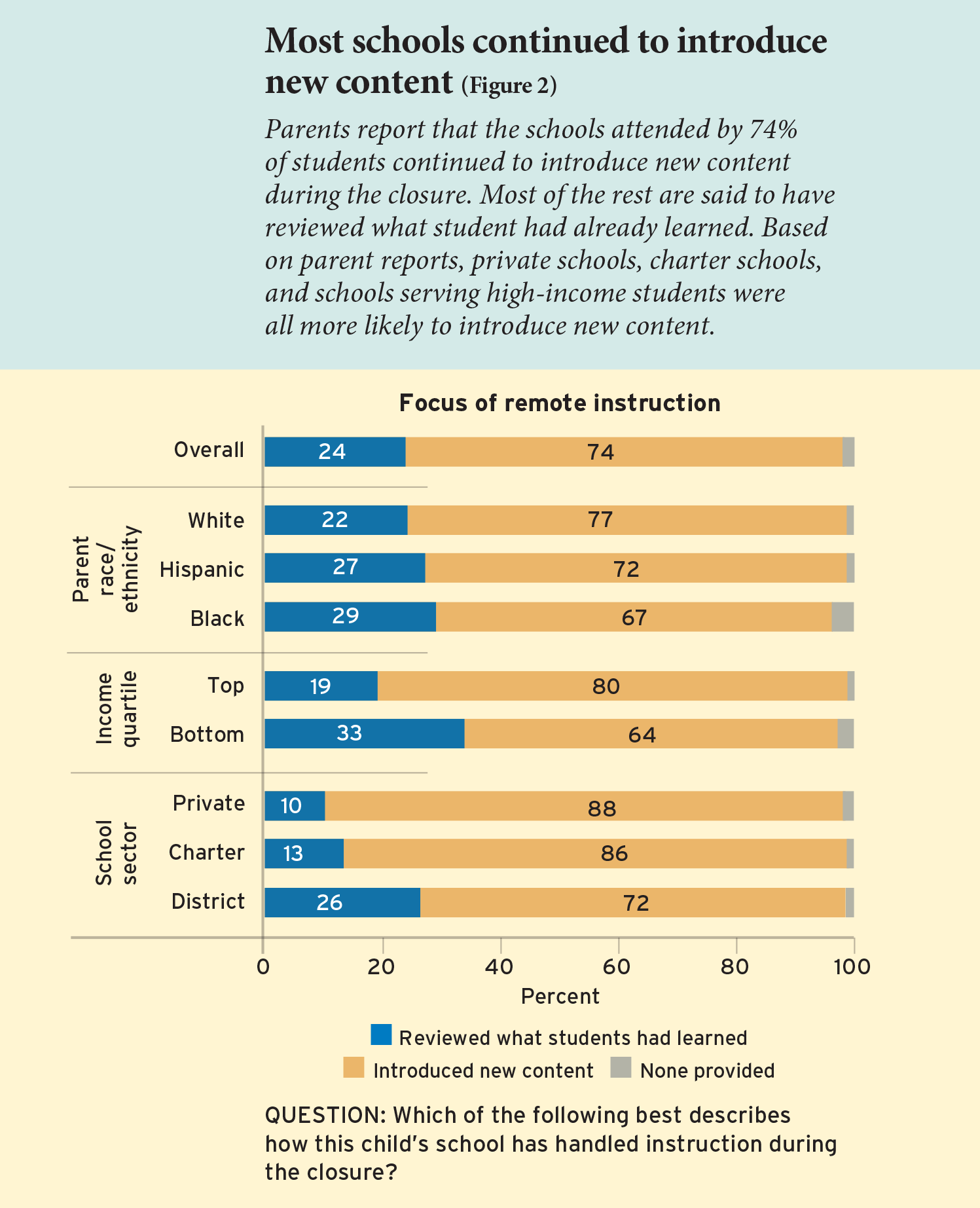
By large measure, most remote instruction was delivered online. The parents of 87% of children say that their child participated “primarily on a computer, tablet, or similar device.” This was the case for 73% of lower elementary students and for nearly all high school students (96%).
Responses vary more widely in regard to how often children heard from their teachers and schools (see Figure 3). While some parents say their child interacted regularly with their teachers during the closure, others say they went for long stretches with little or no contact. For example, the parents of nearly half of students (46%) say their child met with a teacher multiple times during a typical week for whole-class instruction delivered by videoconference or some other way. Another 24% are said to have done so just once a week, while about one in five students (19%) are said to have had no live whole-class instruction.
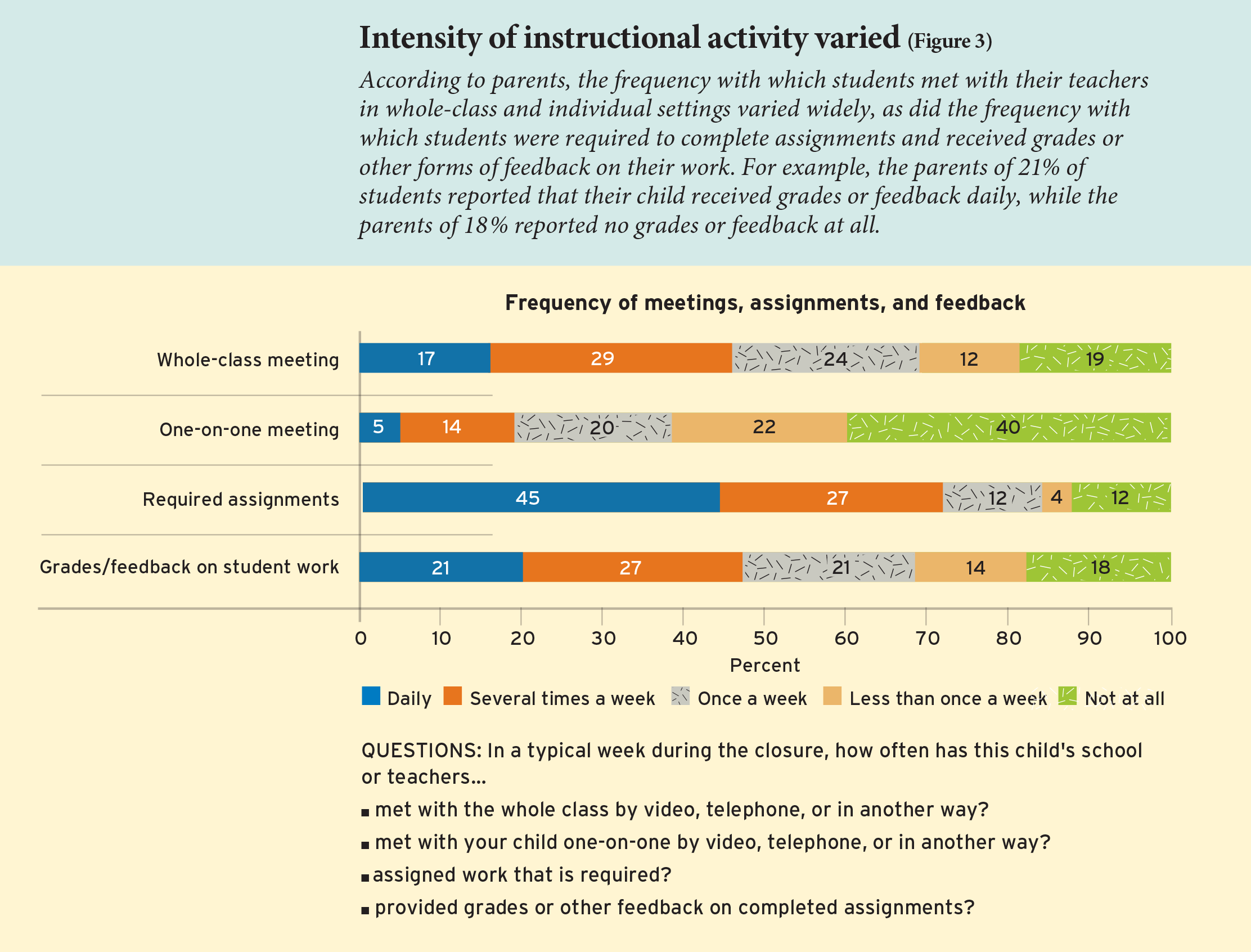
Students appear to have had even less one-on-one interaction with their teachers. Parents of just 19% of students report individual contact with teachers by video, phone, or some other way multiple times a week. The parents of 40% of students report that their child had no one-on-one contact with teachers.
The frequency of assignments also varied widely across students. Parents of 45% of students report that their child was assigned required work on a daily basis. Another 27% had required assignments several times a week. On the other hand, parents of more than 1 in 10 students say their child received no required assignments.
Required assignments were less common among students in kindergarten through 2nd grade. Twenty-one percent of these students had no required work, according to parent reports, as compared to 8% in middle and high school. The opposite pattern holds for voluntary assignments, which were most common in lower elementary grades and least common in high school.
About half of students (48%) received grades or other feedback on completed assignments several times a week or more. Another 21% received feedback just once a week, while 18% did not receive any feedback on their completed assignments during the closure.
Grades and feedback were most frequent in middle and high school, perhaps because of the greater frequency of required assignments in those grades. Parents of most middle and high school students say their child received feedback or grades at least several times a week. But parents of just 44% of upper elementary school students and 38% of lower elementary students say their kids got such feedback that often. One third of lower elementary school students are said to have received no grades or feedback on completed assignments.
According to their parents, American students on average spent 3.4 hours on schoolwork during a typical day during closures—a figure that varied across grade levels. Lower elementary students are said to have spent 2.9 hours, on average, while for high school students the number was 3.8 hours.
Parents, in turn, say they spent an average of 2 hours in a typical day helping with schoolwork. Those with multiple children at home bore the heaviest load: Parents with only one school-age child in their household report spending 1.6 hours on a typical day helping their child. For parents with four children, that number rose to 3.7 hours.
As noted above, the parents of 72% of students say that they are satisfied with the instruction and activities provided by their child’s school during the closure; 28% report that they are “very satisfied.” Despite this generally high level of satisfaction, there is evidence that they would have welcomed more instruction, assignments, and feedback. Across every measure we used—including the number of assignments students received, the time they spent on their schoolwork, and the frequency with which they interacted with teachers—parental satisfaction rose with greater intensity of instruction (see Figure 4). To provide just one example, the parents of 35 percent of children who reportedly received grades or other feedback multiple times of week say they are “very satisfied” with their school’s response. This number falls to 21 percent for the parents of children who reportedly received this kind of feedback once a week or less.
More to the point, the parents of fully 71% of students assert that their child learned less than they would have had their school not closed, with the parents of 29% saying the child learned “a lot less.” The parents of 17% of students say their child learned about the same, and the parents of only 12% of students say their child learned more.
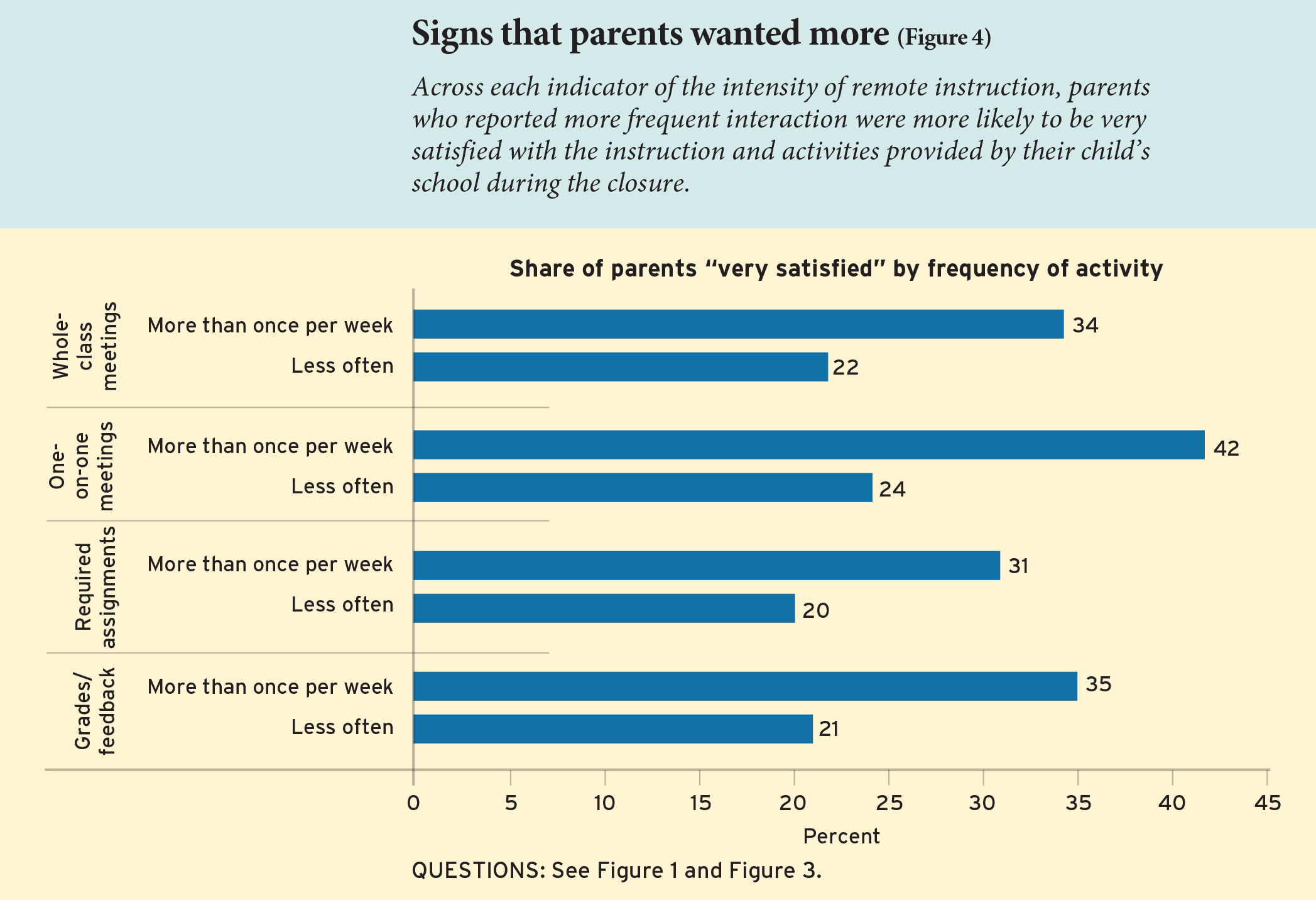
Teachers’ Perspectives
We also surveyed a sample of 490 K–12 teachers who work in schools that closed during the pandemic. Our questions for teachers parallel those we asked parents. Generally, teachers’ responses are consistent with how parents describe their children’s experiences, but a few exceptions arise.
One exception concerns the frequency of one-to-one contact between teachers and students. According to parents, only 19% of students met with their teachers individually multiple times a week; 36% of teachers, however, say they met with their students that often. Teachers also report providing grades or feedback on assignments more often than parents say such feedback occurred. Fifty-nine percent of teachers say they provided feedback on completed assignments multiple times a week. These seeming discrepancies could reflect teachers having met with or provided feedback to some but not all of their students on a regular basis, or they could reflect differences in class sizes across teachers (that is, if teachers who maintained more contact with their students taught fewer students than teachers who had less contact with their students).
By contrast, teachers report providing fewer required assignments than parents say their children received. Whereas the parents of 72% of students say their child had required assignments multiple times throughout a week, just 55% of teachers say they assigned required work this often. American students may have had more flexibility in completing assignments than their parents perceived.
Parents and teachers hold similar opinions on how much students learned after their sudden immersion into the world of distance education. In fact, teachers are even more likely than parents to say children learned less than they would have if schools had remained open. Eighty-seven percent of teachers say their students learned less, including 48% who answered “a lot less.” By comparison, parents of 71% of the students say their children learned less, with 29% saying “a lot less.”
School Closures and Inequality
Many commentators have highlighted the potential for widespread school closures to exacerbate pre-existing racial, ethnic, and economic inequalities. In the absence of in-person schooling, the argument goes, advantaged students will be partially buffered from ill effects because their families generally have more time, flexibility, and resources to offset the reduction in formal instruction. By contrast, students of color and students from low-income families, who were already at a disadvantage before the crisis began, will disproportionately face the negative consequences of the shutdown.
The results from our survey partially corroborate this theory, but they also complicate it. Children of Black, Hispanic, and low-income parents were less likely than children of White and high-income parents to receive instruction from their schools that introduced new content (as opposed to reviewing material already covered), according to their parents. This disparity could lead disadvantaged students to fall further behind. On the other hand, parents of Black, Hispanic, and low-income students report that their children had more frequent interactions with their teachers and spent more hours a day on schoolwork than their White and more affluent counterparts. These same parents say they spent more time helping their children with schoolwork and were less likely to say their child learned less because of the closure. This pattern should not assuage concerns about inequality in the wake of the pandemic. It does, however, shine a spotlight on the hard work that many parents report doing to preempt this problem.
Based on parents’ reports, about 77% of the children of White respondents encountered mostly new instructional content rather than reviewing what they had already learned. By contrast, only about 67% of the children of Black respondents and 72% of the children of Hispanic respondents experienced the same. The difference was starker with respect to family income. About 80% of students in the top quartile of household income received mostly new content compared to only 64% of students in the lowest quartile.
On the other hand, teachers seem to have had more contact with the children of Black and Hispanic parents (see Figure 5). According to their parents, only 30% of the children of White respondents met one-on-one with their teachers at least once a week via phone or the Internet. These rates were noticeably higher for the children of Black respondents (49%) and the children of Hispanic respondents (55%). Similarly, 32% of students in the top income quartile are said to have met one-on-one with their teachers at least once a week, while 50% of students in the lowest income quartile are said to have experienced this same level of contact. This pattern also occurs with respect to the frequency of whole-class contact with teachers, but the differences by parents’ race/ethnicity and household income are less pronounced.
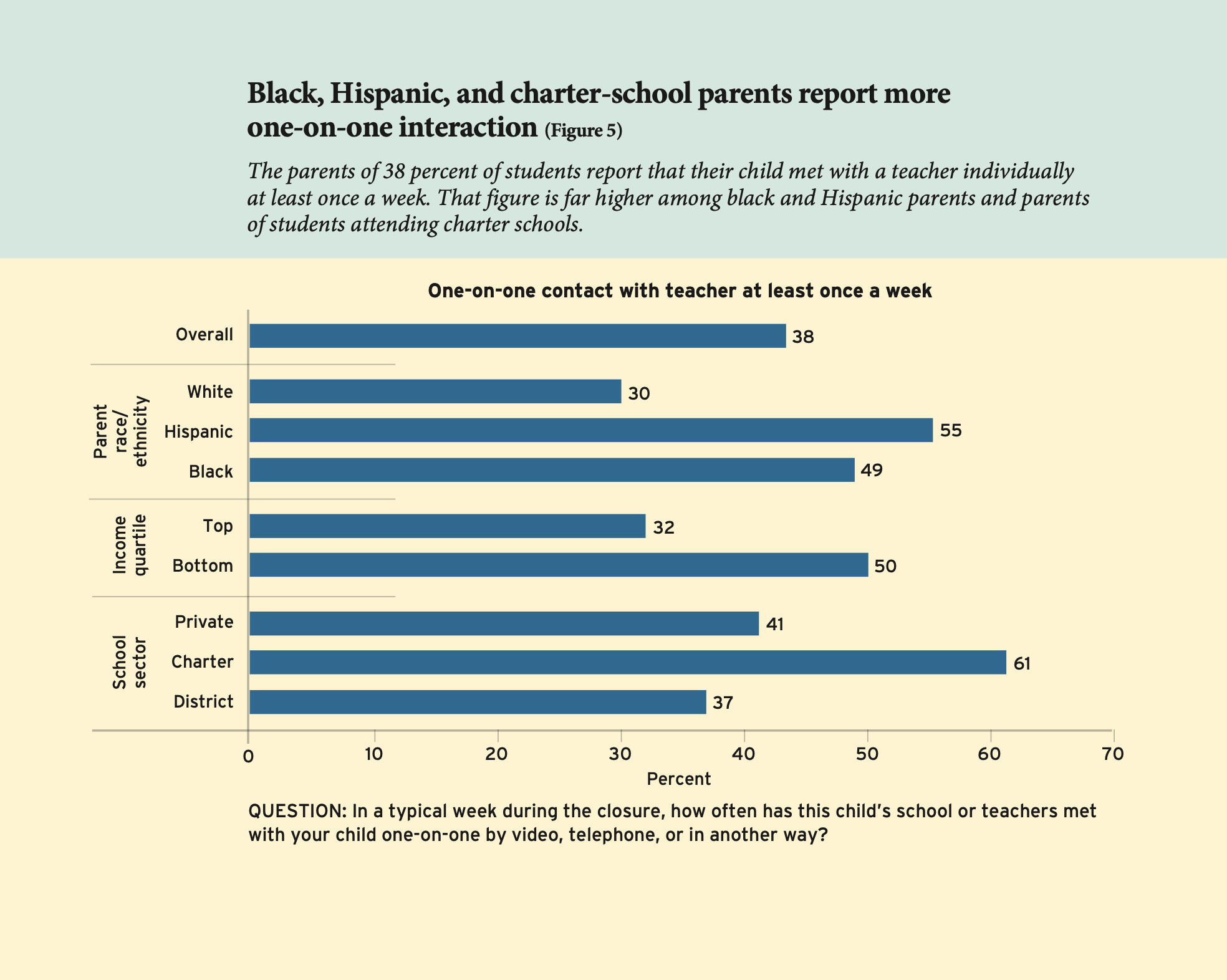
Black and Hispanic parents report that their children devoted substantially more time to schoolwork during the closures than do White parents (see Figure 6). White parents say their children spent about 3.1 hours a day on schoolwork while the schools were closed. Black and Hispanic parents report their children putting in 4.3 hours and 3.9 hours a day, respectively. Similarly, Black and Hispanic parents report spending more time helping their child with schoolwork—a difference that is not explained by variations in household size or family structure. Holding those variables constant, Black and Hispanic parents report spending 1.1 and 0.9 more hours than White parents, respectively. We do not observe differences in students’ time commitment by household income, but we do find that parents in the lowest income quartile report spending more time providing support.
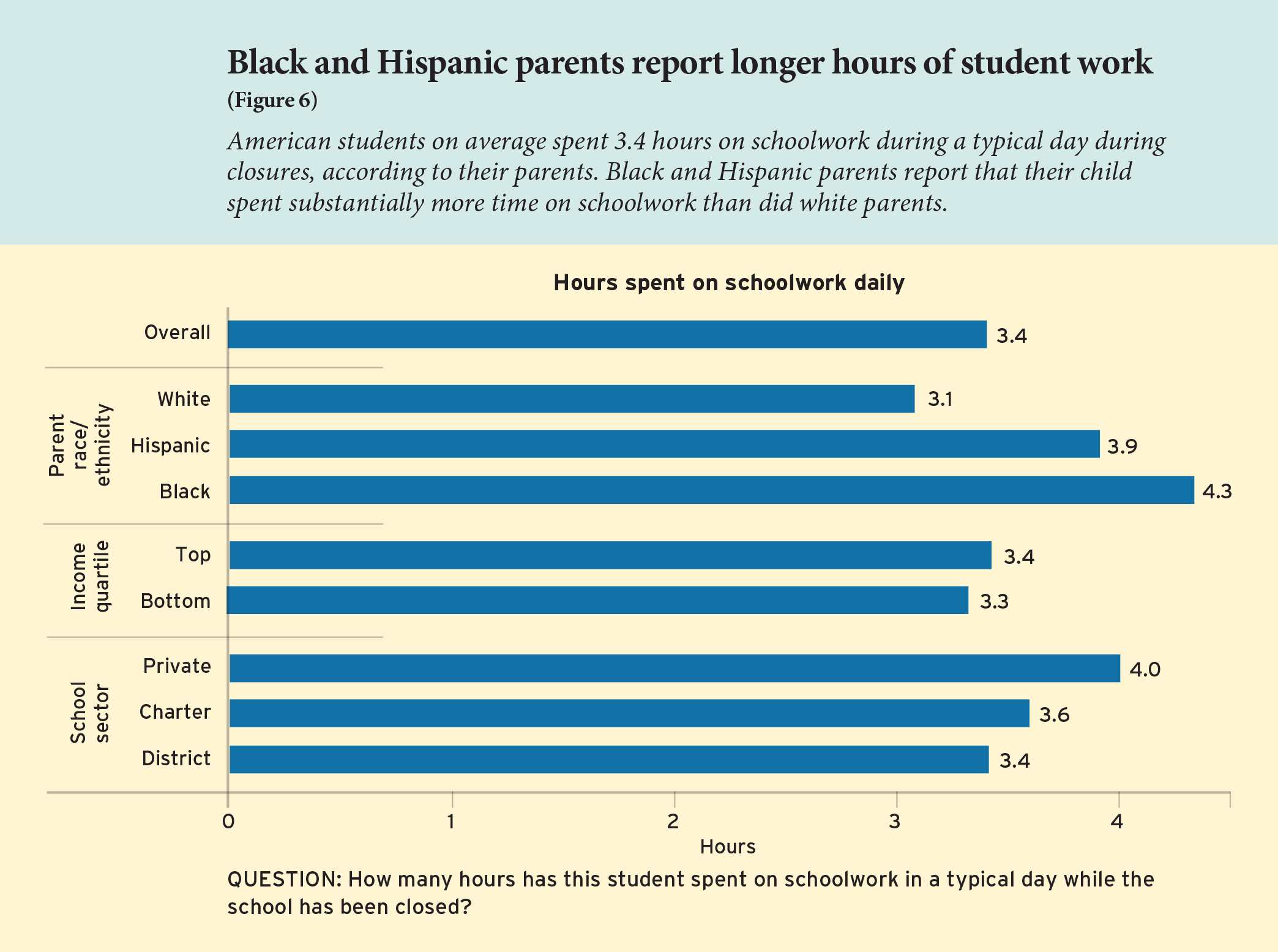
According to their parents, larger shares of the children of White respondents (76%) and children in higher income households (73%) learned less than they would have if schools remained open than was the case for the children of Black respondents (54%), the children of Hispanic respondents (61%), and children in lower income households (57%; see Figure 7). It is not clear whether this is a result of lower expectations of schools in normal times or the result of compensatory efforts among low-income families, families of color, and the schools that serve them. At the same time, we do not observe notable differences in the share of students whose parents are satisfied with their schools’ responses by parents’ race/ethnicity or household income.
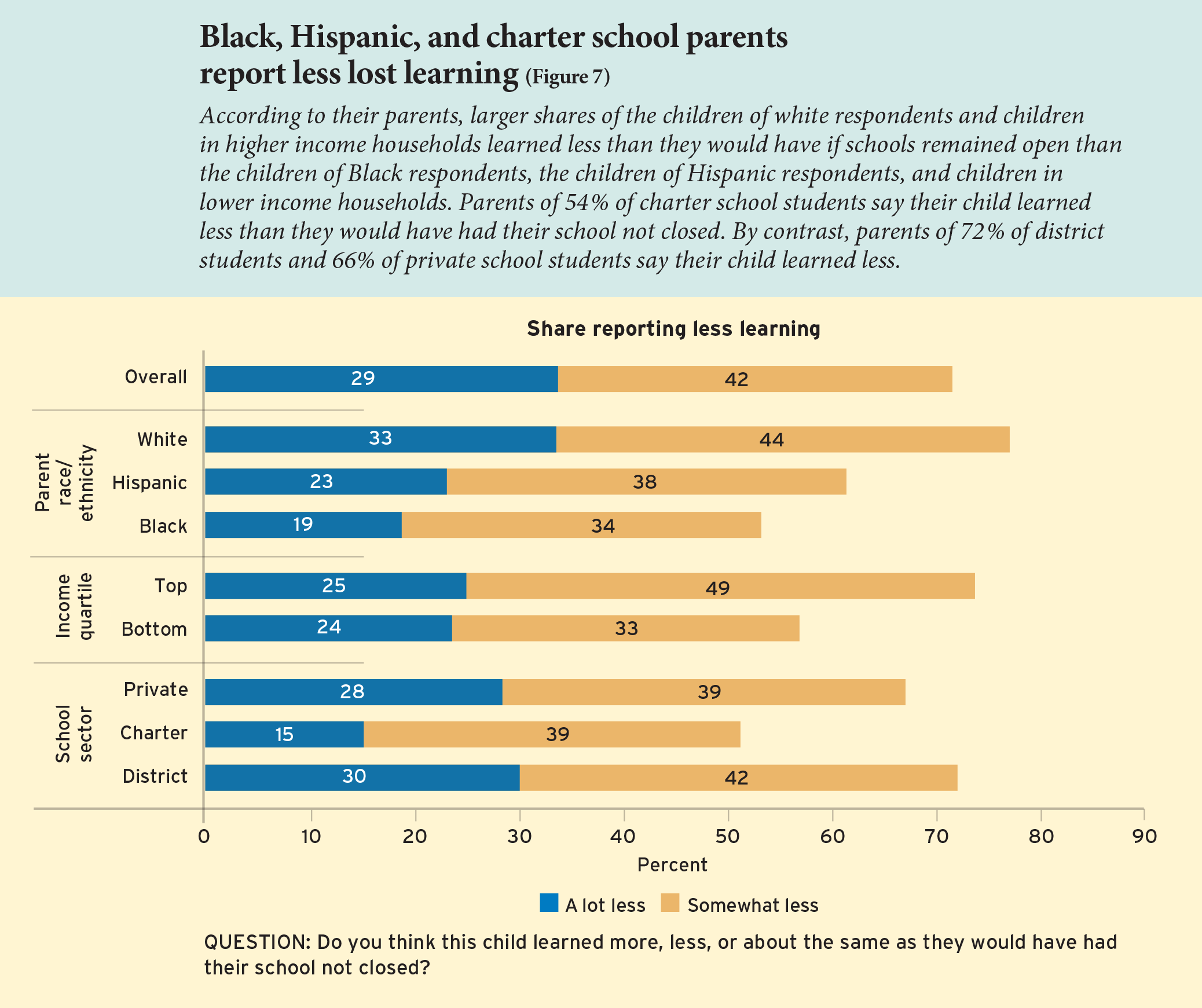
School Responses to Closures by Sector
The nation’s three K–12 educational sectors—district, charter, and private—seem to have responded differently to the challenges posed by the pandemic. Although serious disruptions occurred in all three sectors, there are several indications that charter schools and private schools were better able to adapt to the new learning environment than was the district sector.
Based on their parents’ reports, children in private or charter schools were more likely to receive instruction that introduced new content, as opposed to reviewing what they had already learned. The parents of 88% of private-school students and 86% of charter-school students give that response, as compared to the parents of 72% of district students.
Children in private or charter schools were also more likely to meet with their school or teachers along with their entire class by video, telephone, or in another way. Parents of nearly 70% of private-school students and 62% of charter school students say such meetings took place daily or several times a week, but parents of only 43% of district students give this response. Twenty percent of district students never met with their school or teachers as a class, as compared to 11% of students in the private and charter sectors.
Parents also indicate that charter school teachers had more frequent one-on-one interactions with their students. Parents of only 18% of district school students and 22% of private school students say their child was individually contacted daily or several times a week, but the parents of 42% of charter school students report that frequency of contact.
When asked the frequency with which required work was assigned, parents of 85% of private school students and 79% of charter school students say such assignments occurred daily or several times a week, while the parents of 71% of district students say that. Nor is it the case that district schools offset their tendency to provide required assignments less frequently by giving voluntary assignments more often. In fact, the three sectors were similar in their frequency of providing voluntary assignments: 47% of district school students, 50% of charter school students, and 52% of private school students had voluntary assignments multiple times a week, according to parent respondents.
Parents of 60% of charter school students say teachers graded assignments or gave other feedback daily or several times a week, but the parents of only 46% of district students report this degree of frequency. (The share among private school students is 56%, which does not differ significantly from either group.)
The parents of most students think their children learned less during the closure than they would have had schools not closed, regardless of sector. However, the share of students who learned less, according to their parents, is significantly lower in the charter sector. Parents of 54% of charter school students say their child learned less than they would have had their school not closed. By contrast, parents of 72% of district students and 66% of private school students say their child learned less. Remarkably, the parents of 30% of charter school students report that their child learned more as a result of the closure. For district and private school students, that number was 11% and 18%, respectively.
Finally, while parents of most students in each sector are satisfied with the instruction and activities that schools provided during the closures, there is some evidence of greater satisfaction in the charter and private sectors than in the district sector—particularly when focusing on the share of students whose parents say they are “very satisfied” (see Figure 8). Parents of 70% of district students are satisfied, but parents of only 26% of district students are very satisfied. However, parents of 81% charter school students are satisfied, and 45% of these students’ parents are very satisfied. Likewise, parents of 78% of private school students are satisfied with instruction, and parents of 39% of these students are very satisfied. In short, fewer students in charter and private schools than students in district schools have parents who think they learned less during the closure, and more students in charter and private schools than students in district schools have parents who are satisfied with instruction during the closure.
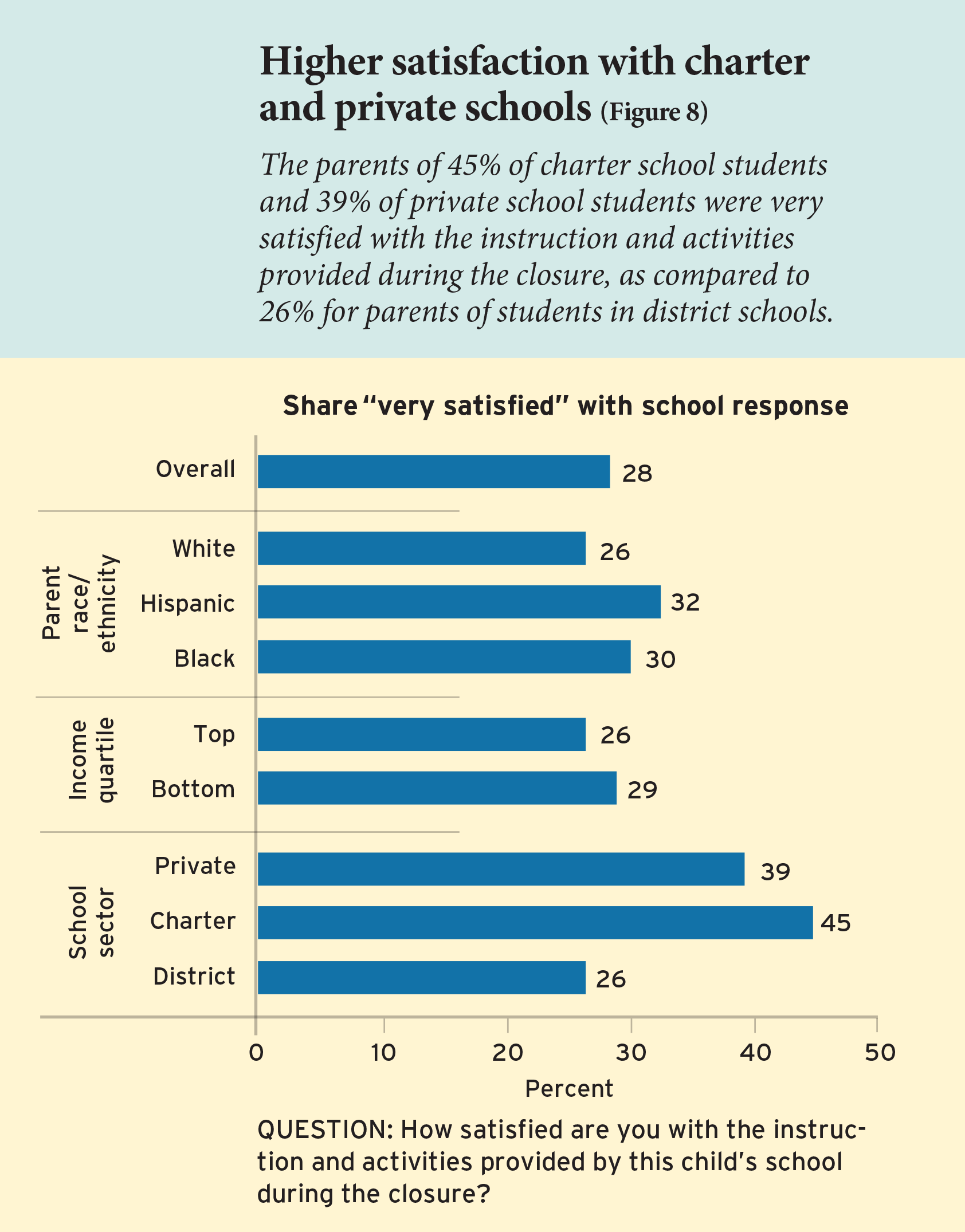
Taken as a whole, our findings highlight the risks to students’ educational well-being if schools do not reopen this fall. Overwhelming majorities of both teachers and parents report that students learned less when schooling went remote, with the parents of more than a quarter of students and just about half of the teachers reporting that students learned “a lot less.” Many other findings from our survey suggest that students did not receive the same face-to-face interactions (even on a screen) with their teachers that ordinarily take place inside the school building. Admittedly, a majority of parents say they are satisfied with the school’s response, but these expressions likely convey generosity toward educators who faced sudden and enormous challenges as the pandemic spread. If schools do remain closed, school districts would do well to look to the private and charter sectors for ways to strengthen school-student connections in remote settings. But even at charter schools, the parents of 54% of students said their child learned less via remote schooling than they would have otherwise. For most students, the best way to learn is very likely through in-person instruction and guidance from a teacher.
Michael B. Henderson is assistant professor at Louisiana State University’s Manship School of Mass Communication and director of its Public Policy Research Lab. David M. Houston is assistant professor of education policy at George Mason University. Paul E. Peterson is the Henry Lee Shattuck Professor of Government at Harvard University, Director of Harvard’s Program on Education Policy and Governance (PEPG), and Senior Editor of Education Next. Martin R. West is the William Henry Bloomberg Professor of Education at Harvard University, Deputy Director of PEPG, and Editor-in-chief of Education Next.
|
Methodology The data for this report come from the 14th annual Education Next survey, a series that began in 2007. Results from all prior surveys are available at www.educationnext.org/edfacts. The survey was conducted from May 14 to May 20, 2020, by the polling firm Ipsos Public Affairs via its KnowledgePanel®. In its KnowledgePanel®, Ipsos Public Affairs maintains a nationally representative panel of adults (obtained via address-based sampling techniques) who agree to participate in a limited number of online surveys. Respondents could elect to complete the survey in English or Spanish. The samples of parents and teachers featured in this report are part of an overall survey sample that includes a nationally representative, stratified sample of adults (age 18 and older) in the United States (1,827), as well as representative oversamples of the following subgroups: parents of children in kindergarten through 12th grade (1,329), teachers (663), Blacks (811), and Hispanics (913). The total sample size for the 2020 Education Next survey is 4,291. The completion rate for this survey is 49%. The main results presented here are based upon a sample of 1,249 parents of students in kindergarten through 12th grade at schools that closed during the pandemic in the spring of 2020. This parent oversample consists of parents, stepparents, or foster parents of at least one child living in the respondent’s household who is in a grade from kindergarten through 12th grade. After initially screening for this qualification, we asked parents the number of their children in kindergarten through 12th grade who live in their household as well as the grade, gender and school type (traditional public school, charter school, private school or home school) for each child. For each child who was not a home school student, we then asked whether the child’s school closed because of the coronavirus outbreak. This screening process yielded the 1,249 parents mentioned above who provided responses for about 2,147 K–12 students whose schools closed. We asked these parents a series of questions about instruction during closure for each child whose school closed. After completing these questions about each child individually, parents answered a final question about the total amount of time they spent helping all of their children combined with schoolwork during the closure. Ipsos Public Affairs provided background demographic characteristics of these parent respondents, including race/ethnicity, household income, gender, and marital status. We do not have measures of the race/ethnicity of their children. In this report, we analyzed responses to questions about individual children at the child level. For example, the 74% of responses indicating schools introduced new material indicates that 74% of K–12 students whose schools closed received instruction introducing new content during the closure, as reported by their parents. Differences discussed in this report are statistically significant at the 0.05 or 0.10 level while clustering standard errors by the respondent (that is, parent). We analyze the question about parents’ time at the parent level. For both student-level and parent-level analyses, we use survey weights designed for representativeness of the national population of parents of school age children. The teacher oversample includes 490 K–12 teachers who work at schools that closed during the coronavirus outbreak. After screening for grade taught, teachers answered a similar battery of questions as parents. However, the teacher battery captures teachers’ experiences as opposed to children’s experiences. For analysis of teachers’ responses, we use survey weights designed for representativeness of the national population of teachers. The exact wording of each question is available at www.educationnext.org/edfacts. Percentages reported in the figures and online tables do not always sum to 100, as a result of rounding to the nearest percentage point. |
This article appeared in the Winter 2021 issue of Education Next. Suggested citation format:
Henderson, M.B., Houston, D.M., Peterson, P.E., and West, M.R. (2021). What American Families Experienced When Covid-19 Closed Their Schools: Parents report little contact with teachers and less student learning, but also broad satisfaction; charter and private schools provide more opportunities for student-teacher interaction. Education Next, 21(1), 22-31.


